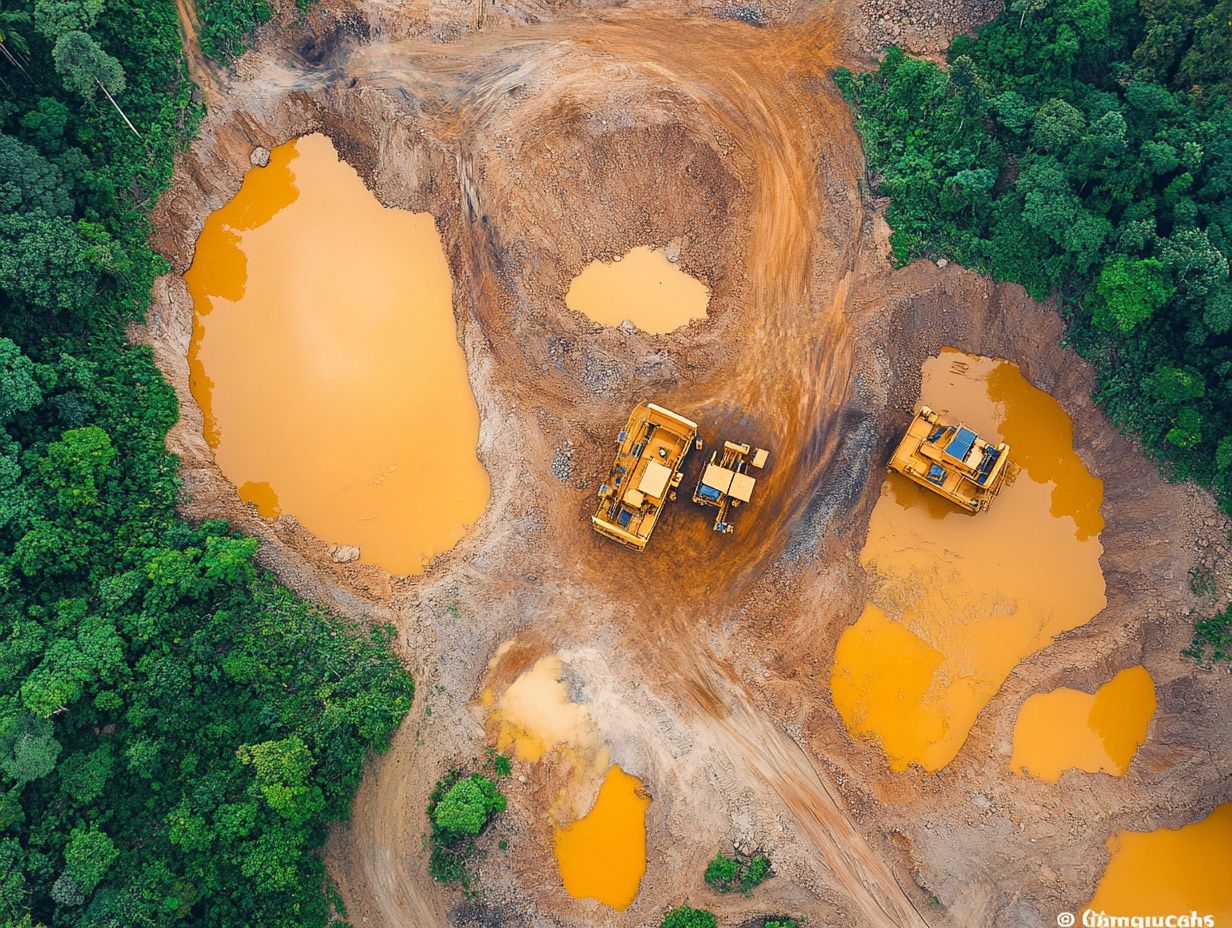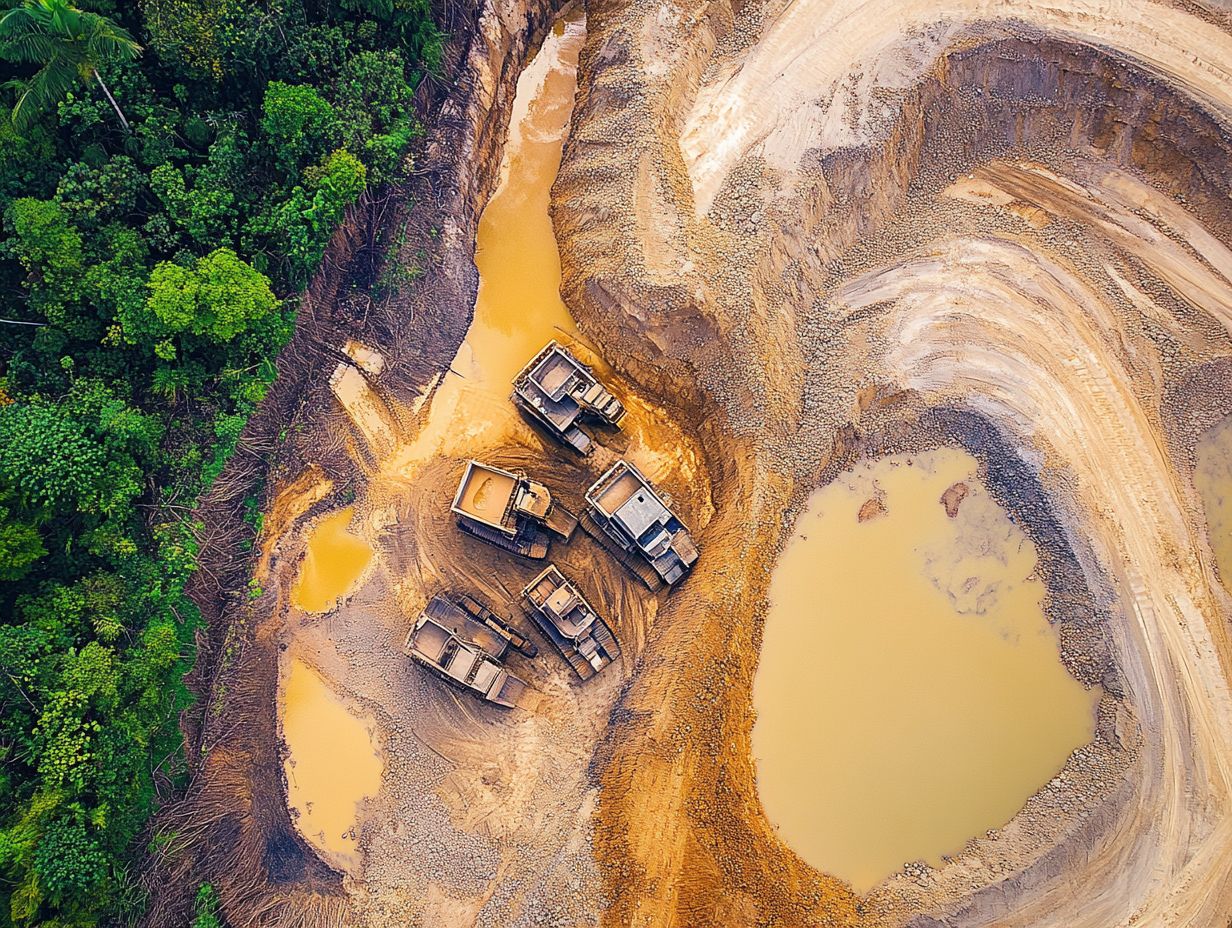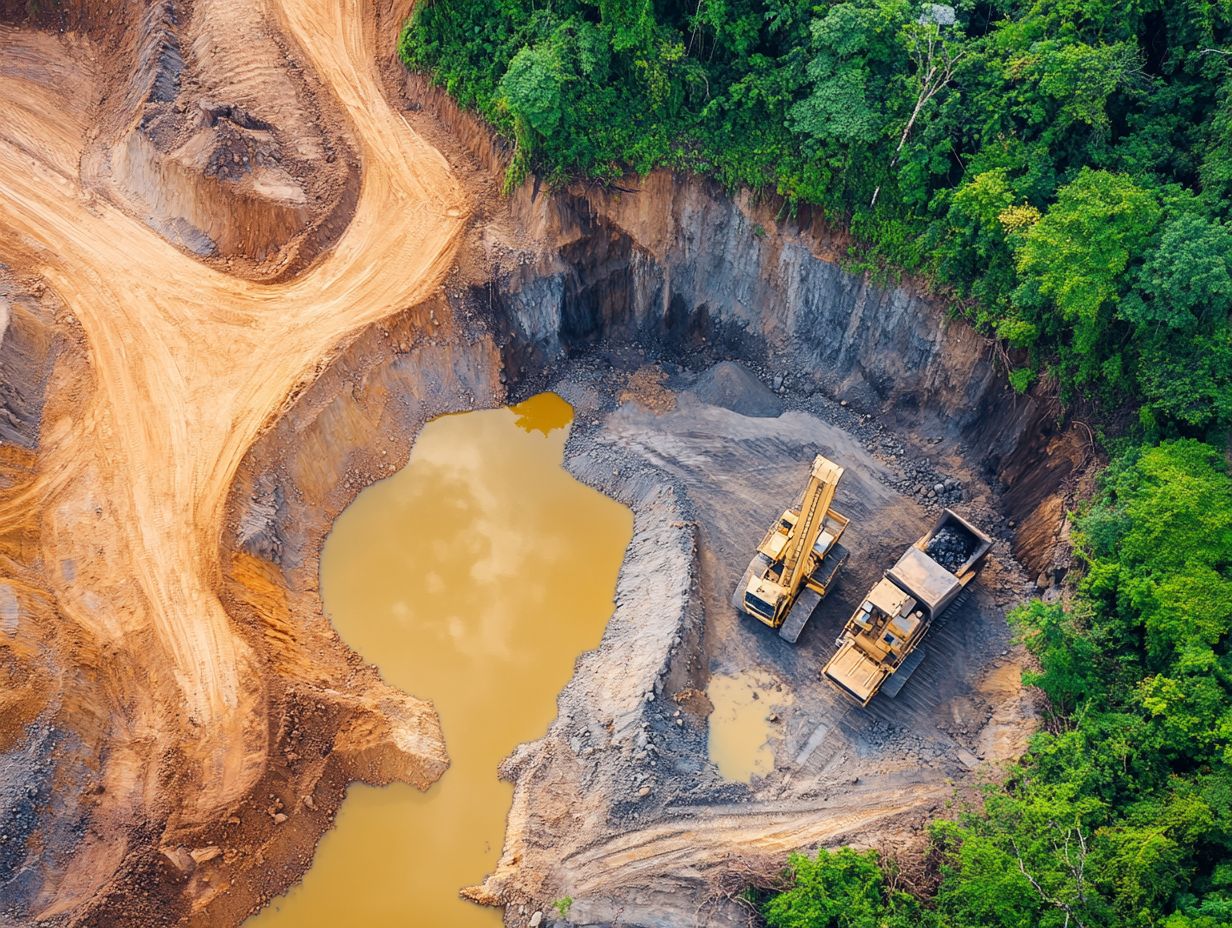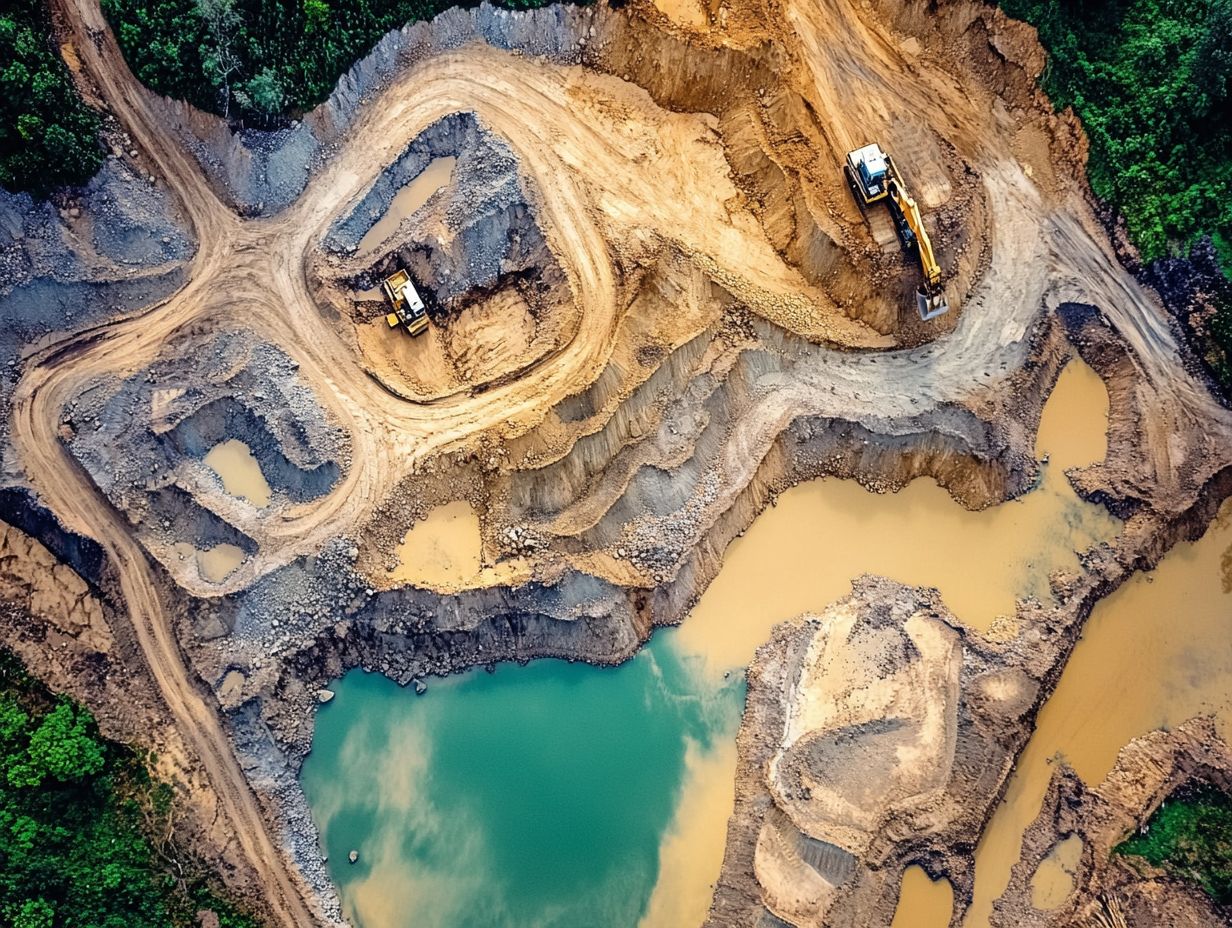The Environmental Impact of Gold Mining
Gold mining has long been celebrated for its economic benefits. However, it comes with significant environmental costs that cannot be overlooked.
This article delves into the various techniques used in gold mining. It illuminates their impacts on land, water, and air.
You ll gain insight into current regulations designed to mitigate damage. You will also discover innovative, sustainable practices that offer a more ethical approach to extraction.
Explore potential solutions that aim to balance profit with environmental care. Dive in to uncover the complex relationship between gold mining and our planet, revealing the intricate dance between wealth and sustainability.
Contents
- Key Takeaways:
- The Basics of Gold Mining
- Environmental Impact of Gold Mining
- Regulations and Reclamation
- Alternative Methods for Gold Extraction
- The Future of Gold Mining and the Environment
- Frequently Asked Questions
- What is the environmental impact of gold mining?
- What are the main environmental concerns associated with gold mining?
- How does gold mining contribute to deforestation?
- What are the long-term effects of gold mining on the environment?
- What measures are being taken to mitigate the environmental impact of gold mining?
- How can individuals help reduce the environmental impact of gold mining?
Key Takeaways:

- Gold mining can bring economic benefits but has major environmental impacts.
- Gold extraction can lead to pollution, deforestation, and loss of wildlife.
- Stricter regulations and sustainable practices are needed to protect our environment.
The Basics of Gold Mining
Gold mining is a complex endeavor that involves extracting precious gold from the earth using various techniques. One such method is surface mining, which can significantly harm the environment, especially in tropical forests where the loss of plant and animal life can be a major concern.
In this industry, players often engage in gold refining to purify the extracted ore. Small-scale mining can provide crucial economic support to local communities, though it may also contribute to environmental degradation.
Understanding these fundamentals is essential for assessing the future of mining operations and their sustainability.
Overview of Techniques and Processes
The primary techniques of gold mining are surface mining and small-scale mining, each offering distinct processes and environmental implications.
Surface mining involves extracting gold from ore situated near the earth’s surface. This method often generates considerable waste and disrupts local ecosystems. It is typically employed by large-scale mining companies, allowing for rapid yields of gold but raising significant concerns regarding environmental impact and policies.
In contrast, small-scale mining is characterized by operations that rely on manual labor and basic tools. While this approach economically supports local communities, it often operates without protective regulations, leading to unsafe working conditions and further environmental degradation.
When you evaluate both methodologies, you uncover a complex balance between the economic benefits they provide and the ecological impacts they impose within the gold mining sector.
Environmental Impact of Gold Mining
The environmental impact of gold mining is truly profound. Activities like deforestation and mercury contamination can wreak havoc on ecosystems, especially in delicate regions such as tropical forests and the Amazon.
This destruction threatens local biodiversity and poses serious risks to community health. It is essential to consider these consequences when evaluating the true cost of gold mining.
Effects on Land, Water, and Air

Gold mining seriously harms our environment. We must adopt sustainable practices now!
As the extraction process disrupts the earth’s crust, it leads to soil erosion, which depletes the land’s fertility. This erosion contributes to sedimentation in nearby waterways, altering hydrology and affecting the flow and quality of local water bodies.
Mining operations often release harmful heavy metals like mercury and arsenic into the environment. This contamination of soil and water supplies poses serious health risks to both workers and nearby residents. Air pollution from dust and toxic gases is linked to respiratory issues.
The effects of gold mining highlight the urgent need for sustainable practices to effectively tackle these environmental challenges.
Regulations and Reclamation
Regulations and reclamation efforts play a crucial role in mitigating the impacts of gold mining. Robust environmental policies enforce sustainable practices and implement restoration strategies to revive degraded lands post-mining operations.
This approach preserves natural ecosystems and ensures that future generations can enjoy the beauty and resources of these landscapes.
Current Laws and Efforts for Restoration
Current laws and restoration efforts in the mining sector emphasize enforcing stringent regulations and implementing effective cleanup strategies. These are essential to tackle the financial liabilities tied to abandoned mines.
These regulations typically require operators to devise comprehensive mine closure plans. Such plans involve detailed assessments of environmental impacts and proactive rehabilitation measures.
Stakeholders including government agencies, mining companies, and local communities are essential for ensuring compliance with these laws.
Recognizing these financial liabilities is crucial for future projects. Ongoing maintenance and monitoring are critical for long-term sustainability.
By fostering collaboration among all parties, the sector aspires to enhance transparency and accountability. This approach paves the way for practices that prioritize ecological health and community well-being, minimizing the adverse effects of mining activities.
Alternative Methods for Gold Extraction
Alternative methods for gold extraction, especially those emphasizing sustainability and ethical practices, are becoming essential solutions. These approaches minimize environmental impacts while fostering economic growth and enhancing community engagement.
Exploring Sustainable and Ethical Practices

Sustainable and ethical practices in gold mining highlight the importance of responsible extraction methods. These methods benefit the environment and uplift local communities, especially through small-scale mining projects (which empower local artisans).
By adopting these practices, we can significantly reduce the ecological footprint of mining while fostering community engagement. Empowering local artisans to participate directly in the industry creates a sense of ownership and responsibility.
When communities get involved in small-scale mining, they often embrace methods that prioritize land restoration and biodiversity conservation. This engagement can lead to tangible economic benefits, such as improved livelihoods and job creation for both men and women, promoting a more equitable distribution of wealth.
With thoughtful regulations and support for artisanal operations, we can strengthen local economies while protecting the environment. This balanced approach to mining shows that positive outcomes are indeed possible for all stakeholders involved.
The Future of Gold Mining and the Environment
The future of gold mining depends on embracing innovative technologies and sustainable practices that prioritize keeping the environment healthy and community well-being.
By addressing pressing challenges within the mining sector, we can pave the way for a more responsible and forward-thinking industry.
Predictions and Potential Solutions
You should expect more use of innovative technologies and restoration research to minimize financial liabilities and mitigate the negative impacts of mining.
As the industry progresses, advancements like automated drilling (machines that help dig faster), real-time data analytics (using data immediately to make better decisions), and eco-friendly extraction methods will emerge as viable solutions.
These technologies not only enhance operational efficiency but also emphasize environmental stewardship, addressing concerns about land degradation and water contamination.
By integrating renewable energy sources, we can dramatically shrink our carbon footprint, paving the way for a more sustainable process.
Companies that embrace these methodologies are likely to comply with stricter regulatory frameworks and attract investors who prioritize responsible mining practices.
Your commitment to innovation and responsible management will be essential as stakeholders strive to find the right balance between profitability and ecological responsibility.
Frequently Asked Questions
What is the environmental impact of gold mining?

The environmental impact of gold mining includes pollution of water sources, destruction of habitats, and emission of toxic chemicals.
What are the main environmental concerns associated with gold mining?
- Water pollution
- Soil erosion
- Deforestation
- Release of toxic chemicals such as mercury and cyanide
How does gold mining contribute to deforestation?
Gold mining often involves clearing large areas of land for mining operations, leading to deforestation and significantly impacting local ecosystems and wildlife habitats.
What are the long-term effects of gold mining on the environment?
Long-term effects of gold mining include:
- Loss of biodiversity
- Depletion of natural resources
- Contamination of water sources
These impacts can have lasting effects on the environment and surrounding communities.
What measures are being taken to mitigate the environmental impact of gold mining?
Measures include:
- Implementing sustainable mining practices
- Using alternative methods to extract gold
- Enforcing stricter regulations on mining companies
How can individuals help reduce the environmental impact of gold mining?
Individuals can help by:
- Recycling gold and other electronic devices
- Supporting responsible mining companies
- Advocating for stricter environmental regulations for mining operations
Join us in championing responsible mining practices today!















